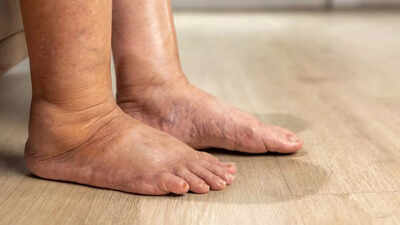Our feet are often overlooked, yet they can provide important clues about overall health. Changes in foot sensation, appearance, or function can indicate underlying systemic conditions that may require medical attention. Studies have shown that foot symptoms can serve as early warning signs for serious diseases such as diabetes and cardiovascular disorders. Research published in the Journal of Diabetes and Metabolic Disorders highlights that diabetic foot ulcers signal poor blood circulation and nerve damage, which are linked to increased heart risk. Similarly, a 2022 study in Circulation emphasizes that abnormal foot temperature, skin color changes, and swelling can indicate peripheral artery disease, a condition closely associated with heart disease. Being aware of these signs allows for timely intervention and can prevent severe complications.
5 warning signs your feet reveal about your overall health
1. Numbness and tinglingPersistent numbness or tingling in the toes and soles may indicate diabetic neuropathy or nerve damage, commonly seen in uncontrolled diabetes. It can also signal nerve compression or other neurological conditions requiring medical assessment. Early detection is critical, as untreated neuropathy can lead to foot injuries, infections, and ulcers.2. Unexplained pain and swellingChronic pain, swelling, or a feeling of heaviness in the feet may point to cardiovascular issues such as edema caused by heart failure or peripheral vascular disease. These symptoms often worsen with activity and improve with rest. Monitoring these signs and consulting a healthcare provider promptly can help prevent further complications.3. Skin changes and discolorationDry, cracked, or discolored skin, along with ulcers or sores that do not heal, can signal poor circulation or infection. This is particularly significant for diabetics, where foot ulcers may escalate to severe infections or even require amputation. According to studies, early recognition of these skin changes allows for interventions that reduce long-term risks.4. Cold feetUnusually cold feet, especially when accompanied by pallor, bluish hues, or redness, may indicate poor blood flow due to peripheral artery disease (PAD). The 2022 Circulation study notes that PAD increases the risk of heart attack and stroke. Prompt evaluation and management of circulation problems can significantly reduce cardiovascular risk.5. Deformities and nail changesFoot deformities such as bunions, hammertoes, or thickened and fungal nails may indicate structural issues or infections that can worsen if untreated. These changes can also be associated with systemic diseases like rheumatoid arthritis, making early recognition and treatment essential for preventing complications.Regular foot examinations, awareness of these warning signs, and proactive medical care are essential not only for foot health but also as early indicators of potentially serious underlying conditions. Monitoring your feet can be a simple yet powerful tool for maintaining overall wellbeing.
